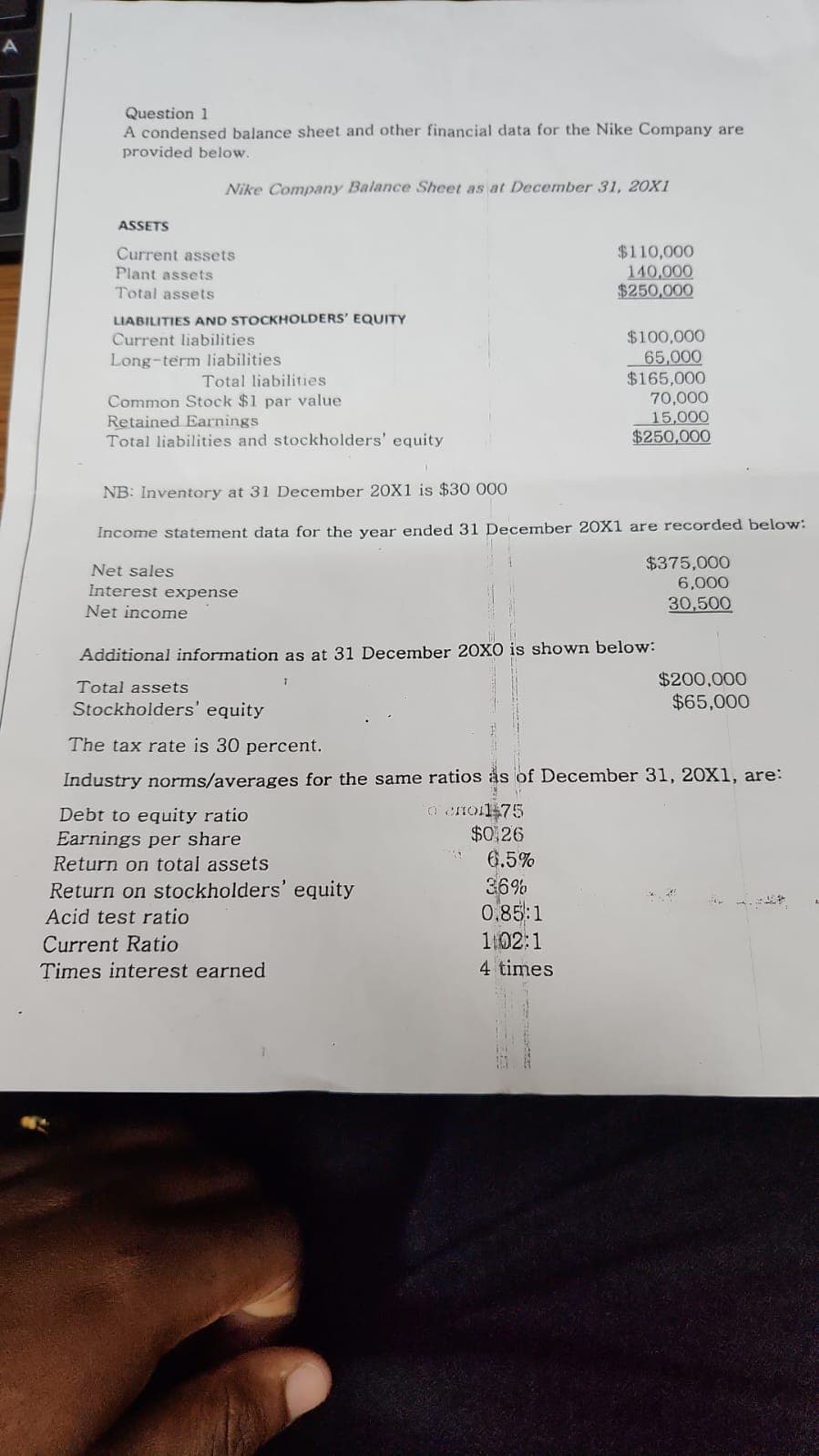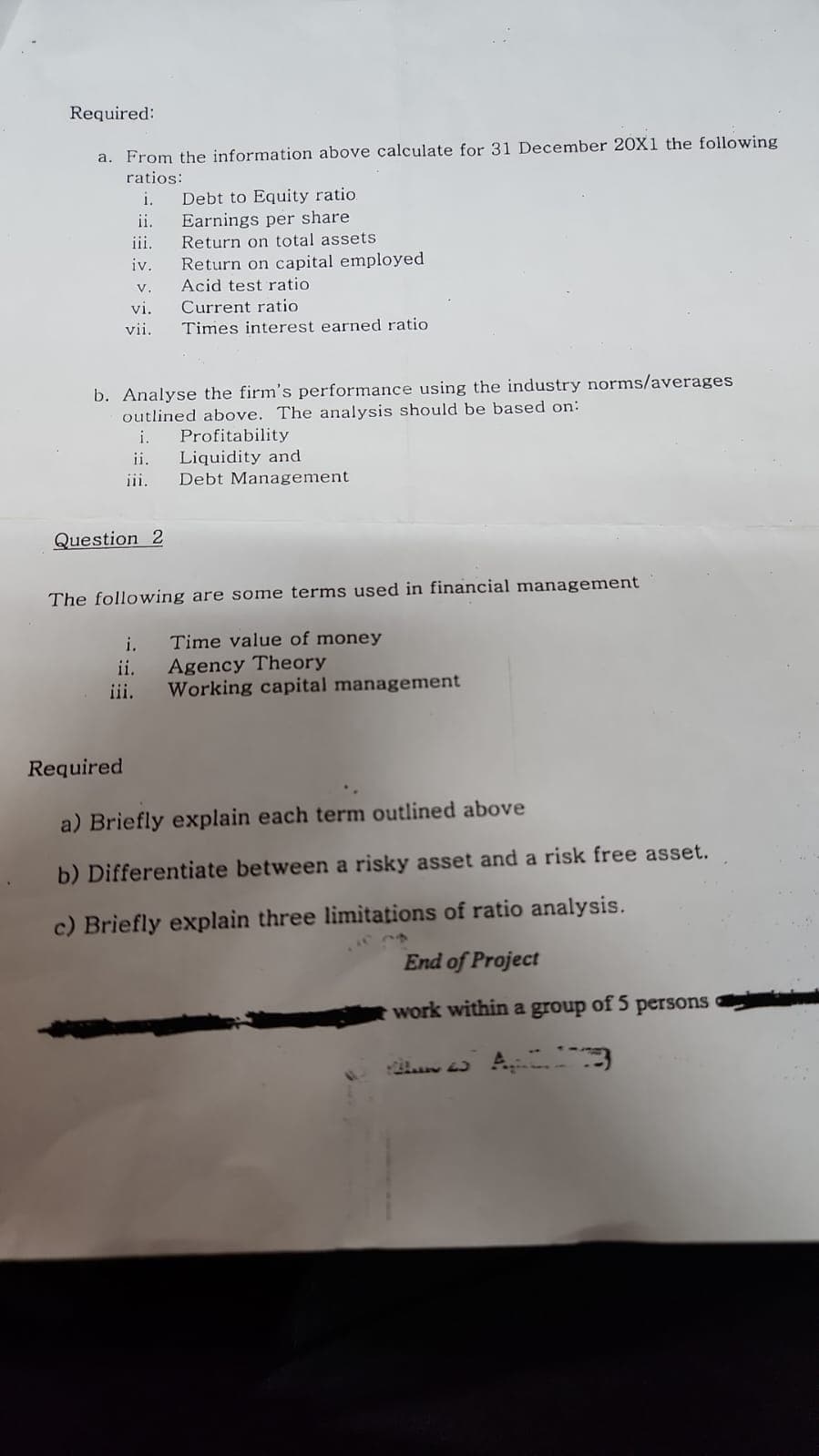Return on capital employed Acid test ratio iv. V. vi. Current ratio vii. Times interest earned ratio Analyse the firm's performance using the industry norms/aw outlined above. The analysis should be based on: i. Profitability
Return on capital employed Acid test ratio iv. V. vi. Current ratio vii. Times interest earned ratio Analyse the firm's performance using the industry norms/aw outlined above. The analysis should be based on: i. Profitability
College Accounting, Chapters 1-27
23rd Edition
ISBN:9781337794756
Author:HEINTZ, James A.
Publisher:HEINTZ, James A.
Chapter24: Analysis Of Financial Statements
Section: Chapter Questions
Problem 10SPA: RATIO ANALY SIS OF COMPARATI VE FIN ANCIAL STATE MENT S Refer to the financial statements in Problem...
Related questions
Question
KINDLY ANSWER PARTS IV & V FOLLOWED BY PART B.i,ii,iii

Transcribed Image Text:A
Question 1
A condensed balance sheet and other financial data for the Nike Company are
provided below.
Nike Company Balance Sheet as at December 31, 20X1
ASSETS
Current assets
Plant assets
Total assets
LIABILITIES AND STOCKHOLDERS' EQUITY
Current liabilities
Long-term liabilities.
Total liabilities
Common Stock $1 par value
Retained Earnings.
Total liabilities and stockholders' equity
Net sales
Interest expense
Net income
NB: Inventory at 31 December 20X1 is $30 000
Income statement data for the year ended 31 December 20X1 are recorded below:
$375,000
6,000
30,500
Current Ratio
Times interest earned
$110,000
140,000
$250,000
6.5%
36%
0.85:1
102:1
4 times
$100,000
65,000
$165,000
Additional information as at 31 December 20X0 is shown below:
Total assets
Stockholders' equity
The tax rate is 30 percent.
Industry norms/averages for the same ratios as of December 31, 20X1, are:
Debt to equity ratio
10 ono11 75
Earnings per share
$0,26
Return on total assets
Return on stockholders' equity
Acid test ratio
alisieren
70,000
15,000
$250,000
$200,000
$65,000
L

Transcribed Image Text:Required:
a. From the information above calculate for 31 December 20X1 the following
ratios:
i. Debt to Equity ratio
ii.
Earnings per share
Return on total assets
Return on capital employed
Acid test ratio.
iii.
iv.
V.
vi.
vii.
b. Analyse the firm's performance using the industry norms/averages
outlined above. The analysis should be based on:
i. Profitability
ii.
iii.
Question 2
Current ratio
Times interest earned ratio
i.
ii.
iii.
Liquidity and
Debt Management
The following are some terms used in financial management
Time value of money
Agency Theory
Working capital management
Required
a) Briefly explain each term outlined above
b) Differentiate between a risky asset and a risk free asset.
c) Briefly explain three limitations of ratio analysis.
End of Project
work within a group of 5 persons
53
ده ست
Expert Solution
This question has been solved!
Explore an expertly crafted, step-by-step solution for a thorough understanding of key concepts.
This is a popular solution!
Trending now
This is a popular solution!
Step by step
Solved in 2 steps with 2 images

Knowledge Booster
Learn more about
Need a deep-dive on the concept behind this application? Look no further. Learn more about this topic, accounting and related others by exploring similar questions and additional content below.Recommended textbooks for you

College Accounting, Chapters 1-27
Accounting
ISBN:
9781337794756
Author:
HEINTZ, James A.
Publisher:
Cengage Learning,

Managerial Accounting
Accounting
ISBN:
9781337912020
Author:
Carl Warren, Ph.d. Cma William B. Tayler
Publisher:
South-Western College Pub

Financial And Managerial Accounting
Accounting
ISBN:
9781337902663
Author:
WARREN, Carl S.
Publisher:
Cengage Learning,

College Accounting, Chapters 1-27
Accounting
ISBN:
9781337794756
Author:
HEINTZ, James A.
Publisher:
Cengage Learning,

Managerial Accounting
Accounting
ISBN:
9781337912020
Author:
Carl Warren, Ph.d. Cma William B. Tayler
Publisher:
South-Western College Pub

Financial And Managerial Accounting
Accounting
ISBN:
9781337902663
Author:
WARREN, Carl S.
Publisher:
Cengage Learning,

Intermediate Accounting: Reporting And Analysis
Accounting
ISBN:
9781337788281
Author:
James M. Wahlen, Jefferson P. Jones, Donald Pagach
Publisher:
Cengage Learning

Cornerstones of Financial Accounting
Accounting
ISBN:
9781337690881
Author:
Jay Rich, Jeff Jones
Publisher:
Cengage Learning

Corporate Financial Accounting
Accounting
ISBN:
9781305653535
Author:
Carl Warren, James M. Reeve, Jonathan Duchac
Publisher:
Cengage Learning